The easiest way to use Publisher is to actually design a publication, and then learn to add features to that publication as we go along.
To start off, we're going to create a blank 8.5 publication, as pictured below. We're going to turn this blank publication into a flyer.
Page Setup Options
If you start with a blank publication and want to create your own, learning to do things such as setting up your page will be very important. The Page Settings dialog box allows you to get started designing your own publication and setting options for it.
To set up your page options, click on the Page Design tab, then go to the Page Setup group. It looks like this:

As you can see, here you can set your margins, the orientation, and the size. Let's discuss what each of these mean.
Margins means the amount of white space that is along the top, bottom, left, and right edges of your publication. Margins are measured in inches.
Orientation refers to either Portrait or Landscape. Portrait means the longer edge of the publication makes up the height (it runs vertical). Landscape means the longer edge goes horizontally across.
Size refers to the size of the publication and directly corresponds to the size you want to print.
Click the arrow at the bottom right corner of the Page Setup group.
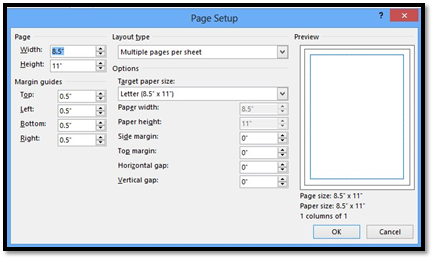
Let's learn how to set the options for your page.
Under the Page section, you're going to enter the height and width of the paper you want to print on.
Under the Margin Guides section, you'll set the amount of white space that goes around the edges of your pages. You'll enter margins for the top, left, bottom, and right. Remember, this is measured in inches.
Next, under the Layout Type section, select the layout type:
-
One Page Per Sheet means that one page of your publication will be printed on one sheet of paper. You can use Print Preview to see how it fits on the page.
-
Booklet means your publication will be in a booklet design. You'll notice the margin guide labels will change. Left will be Outside. Right will be Inside. This lets you know where they appear in your booklet.
-
Email will enable you to create a design for email.
-
Envelope will set you up to create a standard envelope of 9.5 inches by 4.125 inches. If you want to change the measurements, you'll have to change the width and height in the Page section of the window.
-
Folded Card. Use this to create greeting cards. You'll print the sheet, then fold it to make the card. When you choose this layout, sheet fold options are displayed. You can decide how you'll fold your publication. On the right side of the window, Publisher 2013 will show you how your publication will be folded.
-
Web Page allows you to design a web page.
-
If you choose Multiple Pages Per Sheet, you'll print more than one page of your publication on a sheet of paper. When you select this, target sheet options are displayed. Horizontal gap refers to the space between each column of page. Vertical gap refers to the space between rows. The Preview window to the right shows you how it will look.
Click OK when you're finished setting your options.
Using Layout Guides and Rulers
When you're working with a blank publication and designing it yourself, you can use layout guides and rulers to organize and align your text and pictures, as well as other items, into columns and rows. These tools make it a lot easier to design professional-looking documents because it makes lining things up a snap. Without the guides and rulers, it would be hard to create an organized publication.
Layout guides are there to help you align objects (pictures, text boxes, etc.). You can enable the layout guides and get visible guidance to easily align everything on your page. Your layout guides can serve as a grid on your pages and master pages. You'll use the grids to align images, graphics, shapes, and any other object that you insert into a publication.
The layout guides in Publisher 2013 include four layout guides: margin, column, row, and baseline. When you use these, they make up a grid.
To structure a page using layout guides:
First, open a blank publication.
Click the Page Design tab, then click Margins. Select Custom Margins.
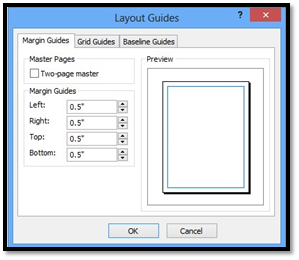
Under the Master Pages category, make sure the Two-Page Master box is checked.
Under Margin Guides, specify the amount of space you want for the Inside, Outside, Top, and Bottom margins. Remember, the space you specify for margins will be the amount of white space around your publication. You can see the current margins in the preview.The outside of the blue box represents margins.
Now, click on the Grid Guides tab.
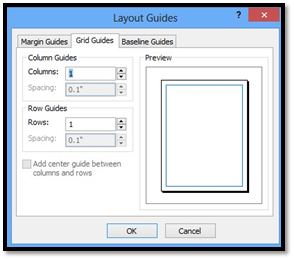
Under the Column Guides section, specify the number of columns in the Columns Box. Then specify the amount of space you want between the columns in the Spacing box. This will add columns to your presentation. You can see by looking at the preview area, below, that we added two columns.
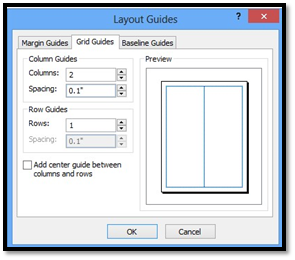
Now, under the Row Guides, do the same thing you did for columns, except this will be for rows.
Clicking Add Center Guide Between Columns and Rows will add an additional guide in the center of the space between your columns and rows.
Next, let's set up the Baseline Guides. Click the tab.
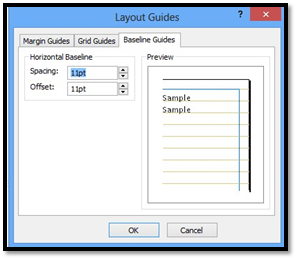
Baseline guides help align the text that is not linked between several text boxes in columns.
Specify the amount of space that you want between the baselines. Click OK when you're finished.
You can also add guides by going to the Layout group under the Page Design tab and clicking the Guides drop-down menu.
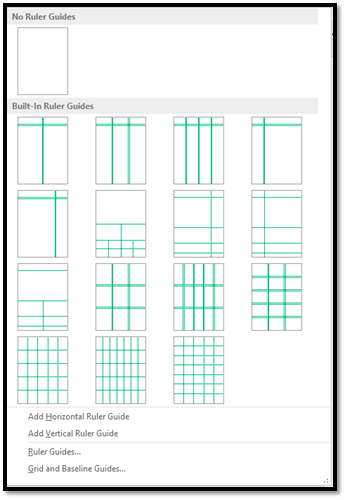
These are the pre-defined ruler guides that Publisher gives you to use. You can select any of these or use the ruler to create your own.
By default, the ruler extends horizontally above your publication and vertically along the left side of your publication. You can see the rules in the snapshot below.
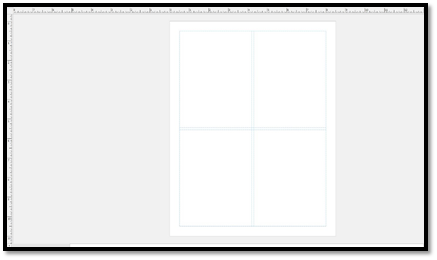
Whenever you move your mouse over the work area, you'll see a black line appear on the rulers that tells you the location of your mouse. You can use this little black line to add guides. This is helpful if you want to align objects to the center of your publication, or at a certain spot in your publication.
Let's show you what we mean. Look at the snapshot below. The black line appears at 4.5 inches (over our publication).

Click on the black line, then go to the Guides drop-down menu and select Add Vertical Ruler Guide. Use the vertical ruler to add a horizontal guide.
Align Objects
When you align objects in your publication, you can align them to either the grid or other objects. To set what you want your objects to align to, go to the Page Design tab, then the Layout group.
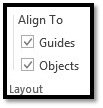
We have it so our objects align to the guides (the grid) and other objects.
Let's show you how it works.
In the snapshot below, we inserted a picture of a cow. To place the image where we want it, we drag and drop. We can align it to the guides. However, we can also align it to other objects.
When you align an object to a guide, the light blue guide gets darker when the object is aligned.
When the object is aligned, release your left mouse button.
Create and Use a Page Background
You can easily change the background of your page from the plain white that you see right now.
To add or change the page background, click the Page Design tab.
Now, click Background in the Page Background group on the far right. Click the Background drop-down menu toward the right side of the ribbon.
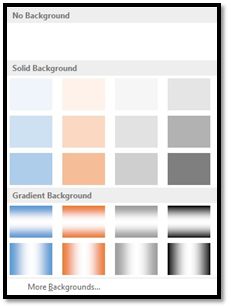
Select the background you want, or click on More Backgrounds.
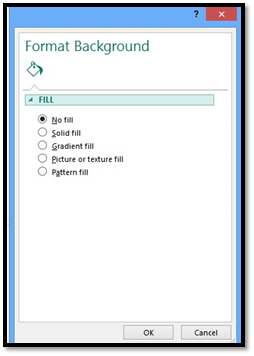
Let's talk about the different types of backgrounds you can create: solid fill, gradient fill, picture or texture fill, and pattern fill.
About Fills
Fills are colors, patterns, and image you add to the background. You can use a solid color fill, such as purple, blue, green, etc. You can also use a gradient fill, pattern fill, or a picture.
Gradient Fills
In a gradient fill, the color is gradually shaded, usually from top to bottom.
A gradient fill is shown below:
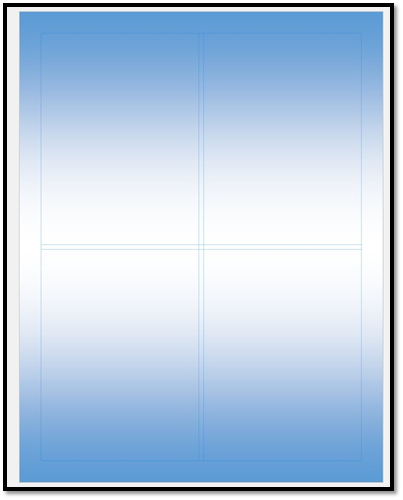
As you can see, the top of the slide is lighter than the middle. This is a gradient.
In the Fill section of the Format Background pane, you can select your fill.
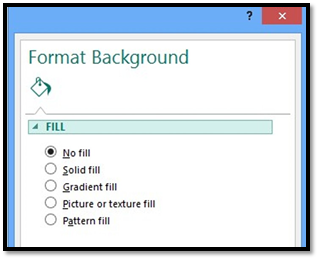
You can select:
-
Solid Fill (you'll then choose a color)
-
Gradient Fill
-
Picture or texture fill
-
Pattern fill
-
Or you can hide background graphics.
When you select a type of fill, you'll see the options for that fill. Below are the options for a gradient fill:
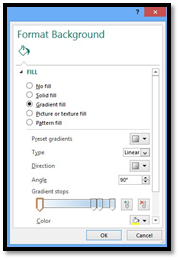
Play with the options for a gradient fill to get the look you want.
Pattern Fill
You also can assign a pattern as a fill.
To assign a pattern, select Pattern Fill from the Format Background pane.
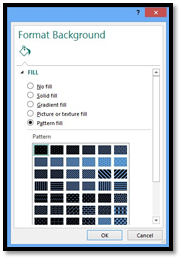
Choose the pattern you want to use, then the foreground and background colors. You can play with this, just as you did with gradients.
Picture and Texture Fills
If you want to apply a picture or texture to the background, click Picture or Texture Fill.
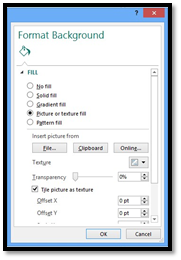
If you want to insert a picture, choose if you want to insert it from:
-
A file on your computer
-
The Clipboard
-
From an image online.
Some images you might use are too dark for a publication, because you can't easily add text over them (and have the text be seen). For that reason, you can increase the transparency of an image you use as the background, so it's lighter and more transparent on the page.
If you want to insert a texture, click the Texture drop-down box:

You'll then see different textures you can apply:
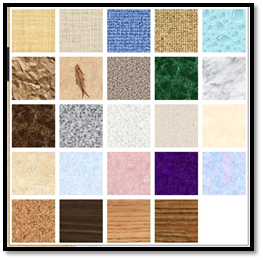
When you're finished adding your fill, click the OK button.
Setting Page Size
When you create a blank publication, you can either choose to create an 8.5 by 11 publication, or an 11 by 8.5 publication. If you want to change the size, you do so using the ribbon, once you've created the blank publication.
To change the size, go to the Page Design tab and click on the drop-down menu below Size in the Page Setup group.
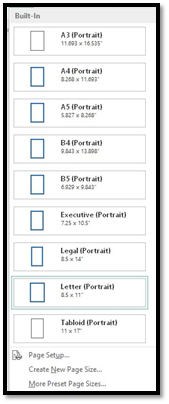
Choose a size from the menu. You can also click Create New Page size to create a size not listed.
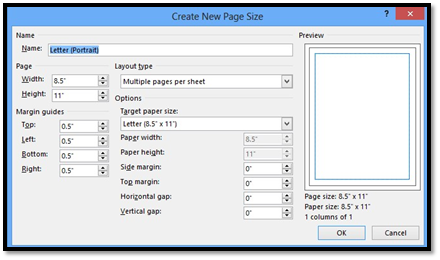
As you can see, you can set the page size, margins, and the layout type just as we did during page setup earlier in this article. Fill out the information in the dialog box, then click OK.
If you want to choose from pre-set page sizes provided by Publisher, click on More Pre-set Page Sizes from the Size drop-down menu.
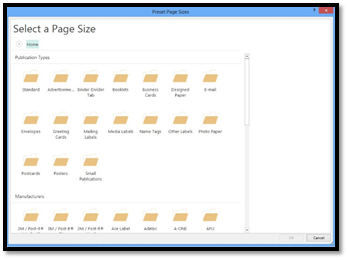
Select a publication type or a manufacturer. For example, if you want to print a 3M Post-It note, you'll want to create the publication to match the size specified by the manufacturer.
We're going to choose Postcards from the publication type.
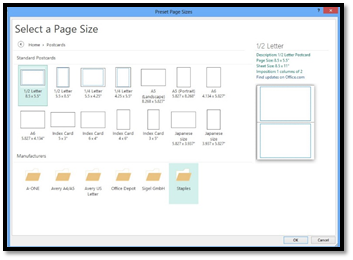
Now you can select a size � or a manufacturer. We're going to choose Office Depot, under Manufacturers.
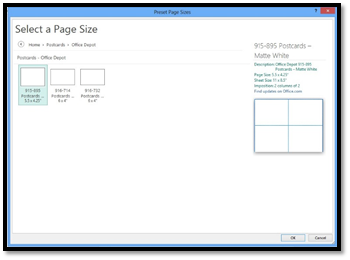
Now we can choose a size.
Click OK when you're finished.
Create and Use Master Pages
The ability to create and apply master pages is one of the best features of Publisher. If you've never used them before (and most people haven't), you're in for a treat. Master pages can save you tons of time and hard work, and help you keep your publications consistent.
Master pages are like overlays that contain design elements you may want to apply to several (or even all) the pages in your publication. For instance, if you were creating a photo album, you might want to create a master page that has placeholders for images. You can use the master page for all pages in the publication, or create different masters. This way, you don't have to recreate layouts each time.
Without master pages, you would have to manually enter all of these elements onto every page -- a very time consuming, labor-intensive process. Even worse, you'd have to re-format each element and position it precisely.
With master pages, you can insert the element only once, and choose which pages you want that element to appear on. Some common elements used in master pages include page numbers, headers, and footers, but you can also add text boxes, artwork, and custom watermarks.
By default, Publisher 2013 automatically includes one master page every time you create a new publication, but you can easily add more.
To view and edit your master pages, click on the View tab. On the far left, you'll find the Views group, as illustrated in the following example.
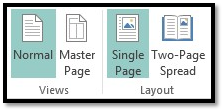
Click the Master Page button. When you do this, the view will change, as in the next example.
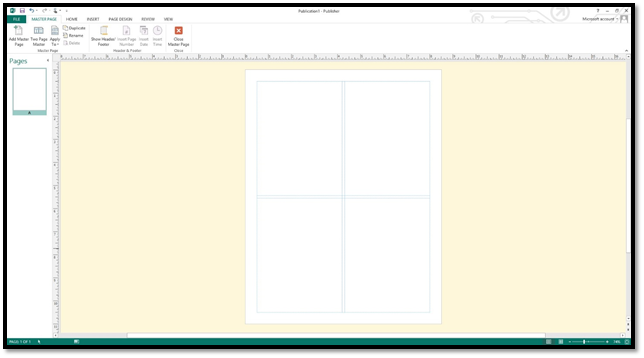
Here you can see that a Master Page tab has been added to the Ribbon. Instead of the pages of your publication, you will only see your master pages in the Page Navigation pane. You can add elements to a master page just like any ordinary page, except that everything you put on a master page will appear on every publication page it is applied to.
To show you how this works, we're going to add a master page, edit it, then apply it to our publication.
There are two ways to add a new master page. The first, and most obvious, is to click the Add Master Page button, which you can see in the upper left of the illustration above. The New Master Page dialog will open.
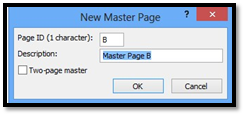
Publisher automatically assigns the new master page an ID. This is basically a numbering system, except instead of calling them page 1, page 2, page 3, etc., we call them page A, page B, page C, etc. You can change this ID if you want, but it's not really a big deal.
In the Description box, you can enter a short description. This can be an easy way to remember what's on a page if you have a lot of them. For instance, you might enter "Title Page," "Chapter Headings," "Artwork," etc.
If you'd like a two-page spread, select the Two-page master box. Click okay when finished.
Another way to create a new master page is to right-click anywhere in the Page Navigation Pane and click Add Master Page.
Sometimes you might want to create a master page based on an existing master page. This is convenient if you already have many elements on a page, and you want to add a few more objects, but not apply them to all the pages in your publication. To do this, right-click on any master page in the Page Navigation pane. Now select, Insert Duplicate Page. Alternatively, you can select a page and click the Insert Duplicate Page in the Master Page tab.
Now let's apply a master page. To do so, simply go to the Master Page tab, select a master page, and click the Apply To button. You'll see a small menu, like this:

You can choose to apply it to all the pages in your publication, to the currently selected page of your publication, or a range of pages.
Let's click Apply Master Page. When we do this, a window will open, asking us to choose a page, or range of pages.
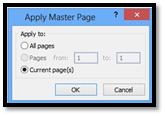
Make a selection, then click OK.
When you are finished creating, editing, or applying your master pages, click the Close Master Page button in the ribbon to return to page view.
You can also use your master pages to apply backgrounds.
To do this, go to the Page Design tab, click the Master Pages drop-down menu, then select the master you want to use for the background.




























